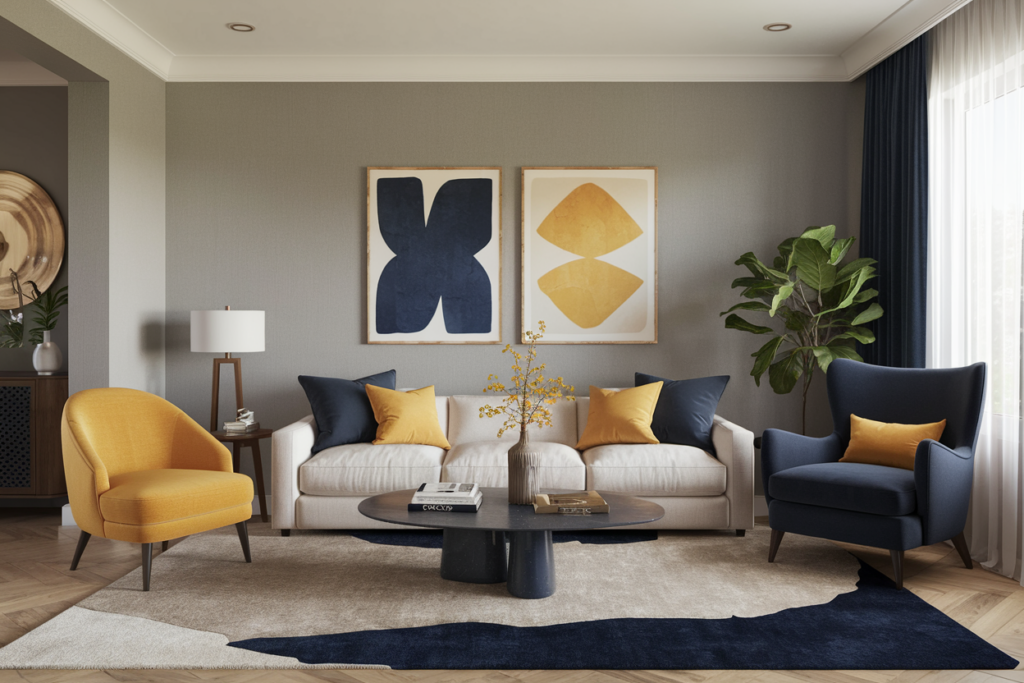
The Power of Color: How to Transform Your Space with the Right Hues
When it comes to designing a room, one of the most impactful yet often underestimated decisions is the color palette. Whether you’re refreshing a living space or starting from scratch, color plays a crucial role in setting the tone, mood, and overall aesthetic of a room. It can make a space feel larger or smaller, energizing or calming, cozy or airy. In this post, we’re diving into how different colors affect a room and how to choose the right shades for your home.
1. Understanding Color Psychology
Colors evoke emotions and can influence how we feel in a space. Here’s a breakdown of how common colors can impact a room’s vibe:
Blue: Known for its calming and serene qualities, blue is perfect for bedrooms and bathrooms where relaxation is key. Lighter blues can make a room feel open and airy, while deeper blues can add a sophisticated touch.
Green: As a color connected to nature, green has a refreshing and rejuvenating effect. It’s a versatile color that works well in living rooms, kitchens, and home offices. Opt for soft, muted greens for a calming feel or bold, emerald greens for a more dramatic look.
Yellow: Bright and cheerful, yellow is an energizing color that can instantly lift the mood of a space. It’s ideal for kitchens or dining rooms, but in large doses, it can feel overwhelming, so use it as an accent or in softer shades.
Red: Red is vibrant and bold, often associated with passion and energy. It’s a great choice for dining rooms as it can stimulate appetite and conversation. In a living room or bedroom, however, it’s best used sparingly as an accent, since too much red can be overstimulating.
Neutral Tones (Beige, Gray, White): Neutrals are timeless and versatile, making them a popular choice for almost any room. They create a calm, balanced environment and serve as a perfect backdrop for adding pops of color through furniture, art, or accessories. Warm neutrals (like taupe or cream) add coziness, while cool neutrals (like light grays) create a modern, minimalist feel.
How Color Affects Room Size and Lighting
Colors don’t just influence the mood—they can also affect how spacious or intimate a room feels. Lighter colors reflect more light, making small rooms feel larger and brighter. White, soft pastels, and light neutrals can open up a cramped space, especially when paired with natural light.
On the other hand, darker colors absorb light and can make a large room feel cozier and more intimate. Deep shades like navy, charcoal, or forest green add depth and sophistication, particularly in larger living areas or dining rooms.
Combining Colors: The 60-30-10 Rule
One of the most effective ways to balance color in a room is by following the 60-30-10 rule. This means:
- 60% of the room should be dominated by one color (usually a neutral or a lighter shade for walls or large pieces of furniture).
- 30% of the room features a secondary color (often for textiles like curtains, rugs, or accent walls).
- 10% of the room uses a bold accent color to add personality and interest (through pillows, artwork, or accessories).
For instance, if you want a cozy, modern living room, your palette might look like this:
- 60% soft gray for walls and a sofa
- 30% deep navy for an accent chair, rug, or curtains
- 10% mustard yellow for throw pillows, artwork, and vases
This approach ensures your space feels cohesive while allowing you to play with bold or complementary colors without overwhelming the senses.

Consider the Room’s Function and Your Personal Style
When choosing a color palette, it’s important to think about how you’ll use the room and what atmosphere you want to create. For instance:
- Bedrooms: Prioritize calming, restful colors like blues, greens, or soft grays. These hues promote relaxation and a sense of peace, ideal for winding down at the end of the day.
- Living Rooms: This is where people gather, so go for warm and welcoming tones like soft yellows, beiges, or terracotta. If you prefer a more modern feel, cooler neutrals paired with vibrant accents can add energy.
- Home Offices: Productivity is key here, so stick with colors that stimulate focus, like soft greens, blues, or even shades of purple, which are linked to creativity.
- Kitchens: Bright, lively colors like yellow, green, or light blue can energize the space, making it a welcoming spot for meals and conversation.
Testing Colors Before Committing
Before you go all in on a color, it’s smart to test a few samples on your walls. Paint can look different depending on the room’s lighting, the size of the space, and even the time of day. Paint swatches in different spots and observe how the color changes throughout the day.
Also, don’t be afraid to mix and match. Sometimes the best results come from combining unexpected colors, creating a truly unique space that reflects your personality.
Color is one of the most powerful tools in interior design. It has the ability to transform a room, set the tone, and reflect your style and personality. Whether you’re painting an entire space or simply adding a few colorful accents, remember that the right color can breathe new life into your home. So take your time, experiment, and have fun creating a space that’s perfect for you!
Happy decorating!
